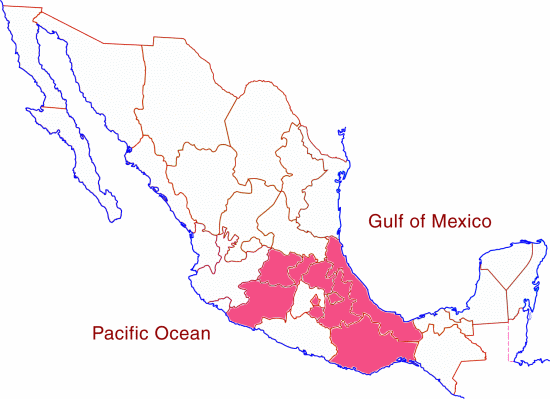In an earlier post, we looked at the ten states with the highest male-female ratios (ie the most males for every 100 females). This time we turn our attention to the ten states with the lowest male-female ratios (or the most females for every 100 males). Male-female ratios are sometimes referred to as “sex ratios”, though that term does not indicate clearly whether the values are males for every 100 females (the usual interpretation) or females for every 100 males.
Male-female ratios are an important demographic statistic and reflect numerous environmental, economic and social factors. In turn, they influence many aspects of economic and social geography. This Wikipedia entry on Human Sex Ratio offers a general introduction to some of the geography associated with male-female ratios.
The table and map show the 10 states in Mexico with the lowest male-female ratios.
Rank State male-female ratio (males/100 females) number of females per 100 males
1= Federal District 91.8 108.9
1= Oaxaca 91.8 108.9
3 Puebla 92.1 108.6
4 Guanajuato 92.8 107.8
5 Hidalgo 93.2 107.3
6 Michoacán 93.4 107.1
7 Morelos 93.5 107.0
8= Tlaxcala 93.7 106.7
8= Veracruz 93.7 106.7
10 Querétaro 94.3 106.0
What do these states have in common?
The short answer would appear to be not very much, apart from forming a band across central Mexico!
The Federal District may offer far more employment opportunities for females than for males. Females who live in other states may be more likely to migrate to Mexico City in search of employment than to attempt the more complicated migration to the USA which has become the preferred option for many young males.
Oaxaca, along with Guanajuato and Michoacán, has a high rate of out-migration. In most situations, demographers consider that males are more more likely to migrate than females. This gender imbalance in migration would leave a low male-female ratio at the place of origin. Out-migration may also explain why Morelos and Tlaxcala, two of the smallest states in Mexico, are on the list.
In conclusion, while male-females ratios are an important population statistic, it is not necessarily always easy to explain them, especially when considering a country as complex as Mexico.
Relevant posts previously published on this blog:
- Females, males and gender inequality in Mexico
- Unemployment in Mexico in 2010
- Women’s empowerment NGO addresses Mexico’s gender inequality issues
Several chapters of Geo-Mexico: the geography and dynamics of modern Mexico discuss population issues, including population growth, distribution, gender differences and density. Buy your copy today to have a handy reference guide to all major aspects of Mexico’s geography!

Sorry, the comment form is closed at this time.